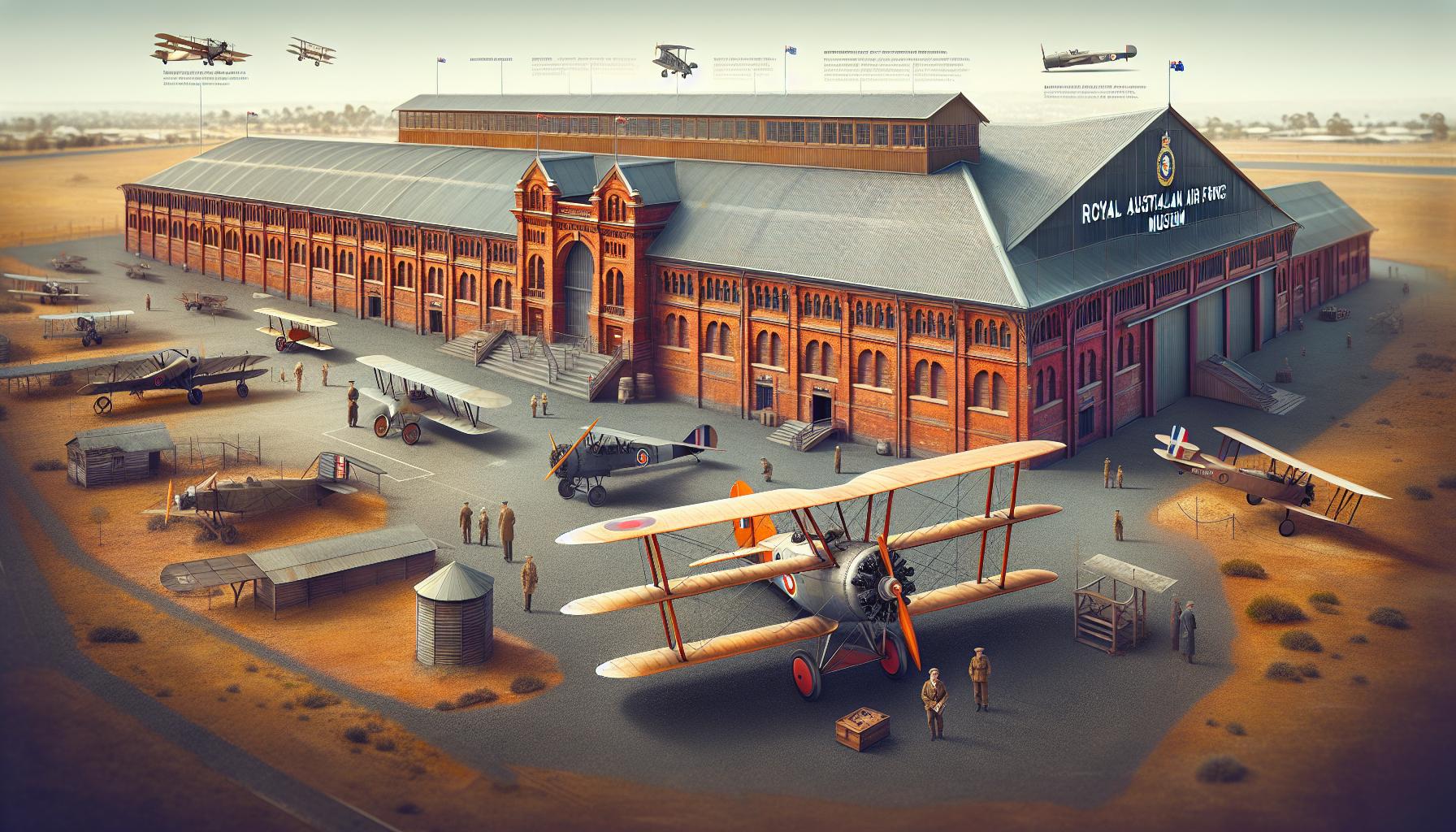Point Cook’s RAAF Base: A Historical Place’s Tale
Background of Point Cook
When I first embarked on this journey to explore the historical monuments of Point Cook, I was captivated by its rich tapestry. Point Cook is not just any location; it’s a suburb steeped in history, with roots that intertwine deeply with the growth of Australia itself.
This locale, named after John M. Cooke, who captained the ship HMS Rattlesnake, holds a special place in Victoria’s history books. As I delved deeper, I discovered Point Cook’s significant role in both military and aviation history. Established as a flight training facility in 1912, it became the birthplace of the Royal Australian Air Force (RAAF). The echoes of the past are palpable as you walk through the area, with each step taking you back in time.
One can’t discuss Point Cook without acknowledging its transformation over the years. Initially embraced for its strategic importance, it has evolved into a vibrant community. The preservation of its historical sites alongside modern development is a balancing act that Point Cook seems to have mastered. Residential areas, parks, and educational institutions now sit alongside heritage-listed military buildings, creating a unique blend of old and new.
What struck me most about Point Cook was not just its landmarks but the stories tethered to them. The suburb doesn’t just house monuments; it serves as a custodian of tales that are waiting to be uncovered. From the pioneering flights that marked Australia’s entry into aviation to the tales of resilience and innovation during wartime, there’s a narrative thread that connects the present to its storied past.
Exploring Point Cook, I felt a deep sense of connection. It wasn’t just about uncovering history; it was about understanding the layers that have shaped this place. The ongoing preservation efforts are a testament to the community’s commitment to keeping the story alive for future generations. As I wandered through the streets, I couldn’t help but feel that I was walking alongside history, witnessing the silent witnesses of bygone eras.
With every discovery, my appreciation for Point Cook grew. Each site, whether it’s a beautifully preserved building or a monument standing tall against the skyline, invites exploration and curiosity. It’s clear that the historical significance of Point Cook is not just a matter of pride for the locals but a beacon for history enthusiasts and casual explorers alike.
Importance of Historical Monuments
Preserving Cultural Heritage
In places like Point Cook, historical monuments aren’t just relics of the past. They’re alive with stories. When I wander through Point Cook, I’m reminded that these monuments preserve our cultural heritage. It’s like they’re custodians of time, holding onto the essence of eras gone by, ensuring future generations know where they come from. They help me, and likely you, feel a connection to the past that textbooks just can’t replicate. It’s this fabric of history, woven intricately with our identity, that these monuments safeguard.
Educational Value
I’ve always believed that monuments serve as outdoor classrooms. Each visit to a historical site in Point Cook is a learning experience. It’s not just about seeing; it’s about understanding the context of our forebears’ struggles and achievements. These places bring history to life. Imagine touching a wall and feeling the weight of centuries under your fingertips. There’s an unmatched power in learning history where it actually happened. It turns abstract dates and events into tangible, unforgettable stories. Through these immersive experiences, monuments teach us more than just facts; they offer insights into the very core of who we are.
The Fascinating Story of Point Cook Air Base
I’ve always been deeply captivated by the stories that historical monuments whisper to those who take the time to listen. Point Cook is no exception, home to the RAAF Museum, a treasure trove of Australia’s aviation history, and a site that holds tales of heroism, innovation, and the unyielding spirit of exploration.
When I first stepped onto the premises of the RAAF Museum, it wasn’t just a walk through a collection of aircraft; it was a step back into a pivotal time in Australian history. The museum, nestled in the heart of Point Cook, serves as a guardian of the stories of the Royal Australian Air Force, from its infancy during the World War eras to its modern-day advancements.
What sets the RAAF Museum apart is not just the extensive collection of aircraft displayed. It’s the personal stories attached to these machines. Each exhibit, each plane, carries with it tales of daring pilots, groundbreaking flights, and moments that changed the course of Australian aviation history.
One of the highlights for me was learning about the First Military Aviation Training Squadron, established at Point Cook in 1914. This marked the birthplace of the Australian Flying Corps, making Point Cook the oldest continuously operating military airbase in the world. Imagine the countless stories of ambition and courage that have taken off from this very point!
Equally fascinating was delving into the stories of the Women’s Auxiliary Australian Air Force (WAAAF), formed during World War II. Their involvement shattered preconceived notions of women’s roles in the military and aviation sectors, laying down a powerful legacy of equality and perseverance.
As I wandered through the museum, the silent aircraft seemed to come alive with stories of technological advances, aerial battles, and peacekeeping missions from across the globe. It’s a vivid reminder of the sacrifices made by the men and women who served in the RAAF, many of whom trained right here at Point Cook.
Beyond the aircraft, the museum also hosts a range of exhibits that delve into the technological evolution of aviation. From early propeller-driven aircraft to modern jet fighters, each piece of technology tells a story of human ingenuity and the unquenchable thirst for pushing boundaries.
Architectural Significance
The airbase is not just a place where aviation history is preserved; it’s a testimony to early 20th-century military architecture. The buildings and hangars, with their distinctly utilitarian design, reflect a period where functionality was as crucial as form.
The main hangar, which houses a vast collection of aircraft, boasts an impressive steel structure. It was designed to accommodate the large wingspans of early aircraft, something that immediately caught my attention. The use of steel, a material not commonly utilised in buildings from that era in Australia, underscores the innovative spirit of the air force at the time.
Walking through the grounds, I noted the red brick buildings that dot the landscape. These were the officers’ quarters and administrative buildings. Their design, with gabled roofs and rows of windows, ensures ample natural light and ventilation, aspects that were vital in the pre-air conditioning age. This choice of material and design speaks volumes about the practical yet aesthetically mindful approach of the architects who contributed to Point Cook’s establishment.
Another striking feature is the runway. It represents the evolution of aviation technology and the adaptation of architecture to support such advancements. The runway has seen various modifications throughout the years to accommodate different types of aircraft, illustrating the dynamic nature of aviation and its architectural needs.
The symbiosis between the built environment and the technological advancements in aviation is perhaps most evident in the maintenance hangars. Here, large sliding doors and high ceilings facilitated the repair and maintenance of aircraft, a critical operation in the air force’s day-to-day activities. These hangars were not only functional but were designed to be quickly and efficiently accessed, a testament to the practical planning of the era.
As I moved from building to building, it became clear to me that Point Cook isn’t just a museum. It’s a historical document, written in brick, steel, and concrete, detailing a story of innovation, practicality, and the relentless pursuit of progress. The architectural significance of Point Cook provides a fascinating lens through which to view the history of military aviation in Australia. It’s a story that’s etched not just in the exhibits it houses but in the very ground and buildings that make up this historic site.
Conclusion
Exploring the RAAF Museum in Point Cook has been a journey through time, where every corner tells a story of bravery, innovation, and progress. It’s fascinating how the architecture itself serves as a testament to the evolution of military aviation in Australia. Walking through the hangars and past the officers’ quarters, I couldn’t help but feel immersed in the rich history that permeates the air. This visit has not only deepened my appreciation for Australia’s military heritage but also reminded me of the relentless human spirit pushing the boundaries of what’s possible. Point Cook is more than just a museum; it’s a beacon of progress and a must-visit for anyone intrigued by the stories that have shaped our world.







